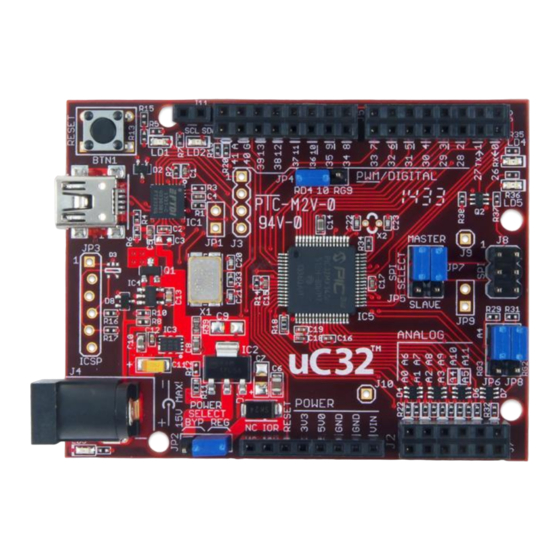Digilent chipKIT uC32 Panduan Referensi - Halaman 8
Jelajahi secara online atau unduh pdf Panduan Referensi untuk Motherboard Digilent chipKIT uC32. Digilent chipKIT uC32 18 halaman.

chipKIT™ uC32™ Board Reference Manual
3.3
5V Compatibility
The PIC32 microcontroller operates at 3.3V. The original Arduino boards operate at 5V, as do many Arduino
shields. There are two issues to consider when dealing with 5V compatibility for 3.3V logic. The first is protection of
3.3V inputs from damage caused by 5V signals. The second is whether the 3.3V output is high enough to be
recognized as a logic high value by a 5V input.
The digital I/O pins on the PIC32 microcontroller are 5V tolerant. The analog capable I/O pins are not 5V tolerant.
To provide 5V tolerance on those pins, the uC32 contains clamp diodes and current limiting resistors to protect
them from 5V input voltages. The fact that all I/O pins are 5V tolerant means that it is safe to apply 5V logic levels
to any pins on the board without risk of damaging the PIC32 microcontroller.
The minimum high-voltage output of the PIC32 microcontroller is rated at 2.4V when sourcing 12mA of current.
When driving a high impedance input (typical of CMOS logic) the output high voltage will be close to 3.3V. Some 5V
devices will recognize this voltage as a logic high input, and some won't. Many 5V logic devices will work reliably
with 3.3V inputs.
3.4
Input/Output Connections
The uC32 board provides 43 of the I/O pins from the PIC32 microcontroller to pins on the input/output connectors
J5, J6, and J7.
The PIC32 microcontroller can source or sink a maximum of 18mA on all digital I/O pins. However, to keep the
output voltage within the specified voltage range (V
12mA. The maximum current that can be sourced or sunk across all I/O pins simultaneously is +/-200mA. The
maximum voltage that can be applied to any I/O pin is 5.5V. For more detailed specifications, refer to the
PIC32MX3XX/4XX data sheet available from the Microchip website.
Connectors J5 and J6 are 2x8 female pin header connectors that provide digital I/O signals. The outer row of pins
(closer to the board edge) corresponds to the I/O connector pins on an Arduino Uno or Duemilanove board. The
inner row of pins provides access to the extra I/O signals provided by the PIC32 microcontroller.
Connector J7 is a 2x6 female pin header connector that provides access to the analog input pins on the
microcontroller. The outer row of pins corresponds to the six analog pins on an Arduino Uno or Duemilanove. The
inner row of pins are the additional I/O signals provided by the PIC32 microcontroller. The analog pins on J7 can
also be used as digital I/O pins.
The chipKIT/Arduino system uses logical pin numbers to identify digital I/O pins on the connectors. The logical pin
numbers for the I/O pins on the uC32 are 0-41. These pin numbers are labeled in the silk screen on the board.
Pin numbers 0-13 are the outer row of pins on J6 and J5, from right to left. Pin numbers 14-19 are the outer row of
pins on J7 from left to right. Pins 20-25 are the inner row of pins on J7 from left to right. Pin numbers 26-41 are the
inner row of pins on J6 and J5 from right to left. The pin labeled A is normally the reference voltage for the
microcontroller's A/D converter, but can also be used as a digital I/O pin via digital pin 42.
In addition to the connector pin, Pin 13 also connects to the user LED LD4. Pin 43 connects to user LED LD5. Pin 43
pin does not go to any connector.
The analog inputs on connector J7 are assigned pin numbers. The outer row of pins on J7 are analog inputs A0-A5.
The inner row of pins are A6-A11. These pins are also assigned digital pin numbers: A0-A5 are digital pins 14-19,
and A6-A11 are 20-25.
Copyright Digilent, Inc. All rights reserved.
Other product and company names mentioned may be trademarks of their respective owners.
0.4V, V
2.4V) the pin current must be restricted to +7/-
OL
OH
Page 8 of 17
